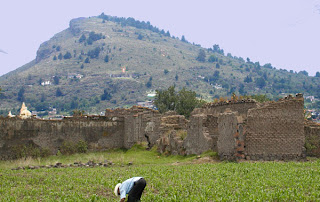
These haciendas are important to out research at Calixtlahuaca because they hold clues to the modern modification of the hillslopes and terraces of the site. After the Spanish conquest, the Postclassic city was abando ned and remaining inhabitants were moved forcibly into Toluca as part of the Spanish “congregación policy (moving or congregating natives into town centers). Spaniards moved into the area and set up haciendas, and by the late nineteenth century the haciendas owned most of the land around Calixtlahuaca (including all of the fertile valley floor). As Mexican haciendas go, these were quite modest in size, in architectural elaboration, and in their landholdings. In 1893 Hacienda Nova owned 6.02 sq. kilometers and Palmillas owned 6.88 sq. km. By contrast, the Hacienda La Gavia some 20 miles to the west owned some 640 sq. km. of land.
ned and remaining inhabitants were moved forcibly into Toluca as part of the Spanish “congregación policy (moving or congregating natives into town centers). Spaniards moved into the area and set up haciendas, and by the late nineteenth century the haciendas owned most of the land around Calixtlahuaca (including all of the fertile valley floor). As Mexican haciendas go, these were quite modest in size, in architectural elaboration, and in their landholdings. In 1893 Hacienda Nova owned 6.02 sq. kilometers and Palmillas owned 6.88 sq. km. By contrast, the Hacienda La Gavia some 20 miles to the west owned some 640 sq. km. of land.
In the 1890s, peasant farmers started moving to the Calixtlahuaca area in large numbers (we are not yet sure why this happened; the data are from state and federal census documents). The only places left to farm were the slopes of Cerro Tenismo, covered with eroding remnant Postclassic terraces. The Postclassic terraces were too narrow to plow with teams of animals, so farmers removed one or more terrace walls to form larger fields to plow. Although this resulted in the destruction of much of the Postclassic terracing and houses, many ancient structures were in fact preserved for the future by the modern terracing. In order to level off their new larger fields, these modern farmers built up the lower sides of the fields with fill, burying a nd preserving the Postclassic deposits. We have managed to locate and excavate several structures and features buried this way.
nd preserving the Postclassic deposits. We have managed to locate and excavate several structures and features buried this way.
I have been looking into historical data on local haciendas and demography in order to better understand the modern reworking of terraces and deposits at Calixtlahuaca. Unfortunately there seem to be few documents on these haciendas, and historians have done little research on the small agricultural haciendas in the Toluca area. We have made some progress, but many questions about the modern re-invasion of the archaeological site remain unanswered. But these are interesting ruins in their own right, and perhaps some historical archaeology is called for. I made the accompanying sketch of of Palmillas by filling in details not visible on our site orthophoto.
No comments:
Post a Comment